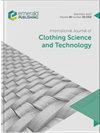圆形设计中应用于服装的纺织品3D打印测试
IF 1
4区 工程技术
Q3 MATERIALS SCIENCE, TEXTILES
International Journal of Clothing Science and Technology
Pub Date : 2023-05-23
DOI:10.1108/ijcst-06-2022-0080
引用次数: 1
摘要
目的探讨各种因素对3D打印材料和雪纺织物粘合强度的影响,并开发一个具有扩展功能的原创设计服装原型,该原型将与圆形设计的细节相兼容。设计/方法/方法选择四种不同的雪纺织物和四种3D打印材料作为研究对象,以确定各种因素对粘合强度和延展性的影响。单轴拉伸试验用于确定夹层的拔出力和拔出伸长率。Findings3D打印的TPU元件可用于连接由低弹性雪纺织物制成的服装部件,以提高穿着舒适性。为了符合循环经济的概念,重要的是选择3D打印元件和材料系统的这样的粘附参数,该粘附参数将确保佩戴舒适性并承受佩戴水平载荷;在服装生命周期结束时,3D打印元件可以从产品中分离出来并回收。独创性/价值开发的系统可用于更新和修复产品,增加独创性、个性化或额外的装饰特征,同时根据循环设计原则扩展服装的功能可能性。本文章由计算机程序翻译,如有差异,请以英文原文为准。
Testing of 3D printing on textile fabrics for garments application within circular design
PurposeTo explore the influence of various factors on the adhesion strength of 3D printing materials and chiffon fabrics, and to develop an original design clothing prototype with an extended functionality that would be compatible with the specifics of the circular design.Design/methodology/approachFour different chiffon fabrics and four 3D printed materials were chosen as the research subjects to determine the influence of various factors on the adhesion strength and ductility. The uniaxial tensile test was used to determine pull-out force and the pull-out elongation from the interlayer.Findings3D printed TPU elements can be used to join clothing parts made from low-elasticity chiffon fabrics to improve wearing comfort. In order to comply with the circular economy concept, it is important to select such adhesion parameters of the 3D printed elements and the material system that would ensure wear comfort and withstand wear-level loads; and at the end of the life cycle of a garment, the 3D printed elements could be separated from the product and recycled.Originality/valueThe systems developed can be used to renew and repair products, adding originality, individual touch or additional decorative features, while extending the functional possibilities of clothing items in accordance with circular design principles.
求助全文
通过发布文献求助,成功后即可免费获取论文全文。
去求助
来源期刊
CiteScore
2.40
自引率
8.30%
发文量
51
审稿时长
10 months
期刊介绍:
Addresses all aspects of the science and technology of clothing-objective measurement techniques, control of fibre and fabric, CAD systems, product testing, sewing, weaving and knitting, inspection systems, drape and finishing, etc. Academic and industrial research findings are published after a stringent review has taken place.

 求助内容:
求助内容: 应助结果提醒方式:
应助结果提醒方式:


